Disclaimer: This article is not intended to be medical advice. Always consult your doctor before beginning an exercise regimen.

Fitness and Recovery After a Collision
After you are involved in an accident, there are many issues that arise. You must deal with insurance, vehicle repair or replacement, financial issues, but most importantly, your health.
Life goes on whether you are physically able or not, so your goal is to be back to full health as quickly as possible.
The best way for this to happen is to prevent injury in the first place. Of course, there are no guarantees, but physical fitness is a good step toward lessening the severity of injury in an accident.
Any injury that you may suffer could heal more quickly with doctor-recommended exercise.
Prior Exercise and Fitness May Prevent Certain Injuries
Bones.The structure of the human body is made up of bones, so it makes sense to begin here when building a strong body. Bones are made stronger through weight-bearing exercise. When the bones are made to bear weight, small electrical impulses send messages to build the bone stronger. Therefore, challenging the bones with weight causes bone density to increase.
Examples of weight-bearing exercises are:
- Walking
- Running
- Climbing stairs
- Weightlifting
- Basketball
Broken bones are a common injury in accidents, so strengthening bones could make overall injury less severe.
Muscles.Muscle injuries, such as whiplash, are common in car accidents. Although they cannot always be prevented with exercise and fitness, the injuries can often be made less severe. Strength training (muscle-building exercises) helps muscles, tendons, and ligaments to be able to undergo more stress before being injured. Therefore, when they are faced with the stress of a crash, this soft tissue is better able to resist the force without injury rather than succumb to it.
Examples of strength training exercises are:
- Sit-ups
- Crunches
- Push-ups
- Bodyweight exercises
Indirect Prevention. While making the body physically stronger and more resistant to injury is the most direct method, exercise can indirectly help to prevent injury by helping the driver be in a safer condition to drive. Many accidents could be avoided simply by having a driver who was more prepared in some way to drive safely.
Better sleep. Exercise has been proven to help people sleep better. Many accidents are caused by drivers who fall asleep at the wheel. Drivers who sleep better at night will tend to be safer drivers the next day.
Sharpens the mind. People who exercise tend to have sharper minds. Their bodies and minds are in more constant communication; therefore, the mind is forced to work in multiple ways. This keeps their minds more active and alert, including while driving.
Boost mood and energy level. Sometimes, drivers are unsafe just because they do not feel up to driving safely. Maybe they are just feeling groggy or have a tendency toward road rage. Regardless of the driver’s intent, these both can lead to unsafe driving. Exercise causes the body to release chemicals that relax people’s moods causing a more even temperament, and it causes people to feel more energetic because it causes the heart and lungs to work more efficiently. These help drivers to be safer on the road.
Recovery
Exercise is a great way to aid in healing if you have an injury, but it is absolutely necessary to consult a medical professional and discuss the safest ways to exercise based on your current condition. That being said, exercise can be very helpful in injury recovery in a number of ways. The best part of this is that exercising the injured area is not required at all for it to be very helpful for healing.
Speeds healing. Two essential types of hormones are necessary for healing – human growth hormone and anabolic hormones. As people age, the production of these hormones decreases, which is why healing becomes slower with age. Exercise, however, dramatically boosts the production of these hormones temporarily. Therefore, regular exercise throughout recovery will keep these levels elevated more often and will speed healing. Notice that it does not matter what part of the body is moving. The only thing necessary for this benefit is physical exertion.
Reduces inflammation. Inflammation was designed to be helpful, and in many ways, it is. It is our immune system’s response to all the bad stuff that comes our way, whether it be physical or emotional. Inflammation is what makes the area around a cut red or what causes lymph nodes to swell when we are sick. This is simply the body’s trying to fight for itself, and helping you get well more quickly. It really is a helpful mechanism.
Sometimes, though, inflammation can go too far. This is especially true in the case of stress. One type of inflammation occurs when adrenaline floods the body when stress levels are elevated.
This can save your life when it occurs at a critical moment, but if the stress is chronic, so is the body’s response. Elevated adrenaline levels can cause a host of issues including problems with the heart, intestines, and bones. This type of problem can dramatically slow healing, and often impacts accident victims because of the stress from issues that arise from the accident.
The good news is that in addition to a diet of anti-inflammatory foods, exercise is a great way to dramatically reduce excess inflammation. Regular exercise helps the mind to reduce stress and the body to regulate inflammation.
Conclusion
Having a doctor-approved exercise regimen is a huge help to many areas of your health, and it is certainly an effective aid in preventing and healing injuries from accidents. However, the best way to stay healthy is to be safe in the first place. No matter how physically fit you are, take all the safety precautions you can.
Even the most physically fit people die in car accidents every day. Always drive safely and carefully, wear seatbelts, and look for dangers on the roadways. Fitness cannot replace safe driving, but it can be its helpful sidekick.
Sources
Experience Life https://experiencelife.com/articles/how-exercise-heals/
Stretch Coach https://stretchcoach.com/articles/strength-training/
Mayo Clinic https://www.mayoclinic.org/healthy-lifestyle/fitness/in-depth/exercise/art-20048389?pg=1
Gnolls https://www.gnolls.org/191/walk-it-off-sally-why-exercise-helps-speed-injury-recovery/
Jeffery Robinette was admitted to practice law in 1991 and is licensed in all levels of state and federal trial courts in West Virginia. Mr. Robinette is also licensed in all state and federal appeals courts in West Virginia and the United States Supreme Court. As a National Board Certified Trial Attorney who has handled hundreds of motor vehicle, injury, and construction defect claims and a leading author on insurance claims settlement issues and difficulties in West Virginia, Jeff Robinette is uniquely qualified to represent your best interest.




